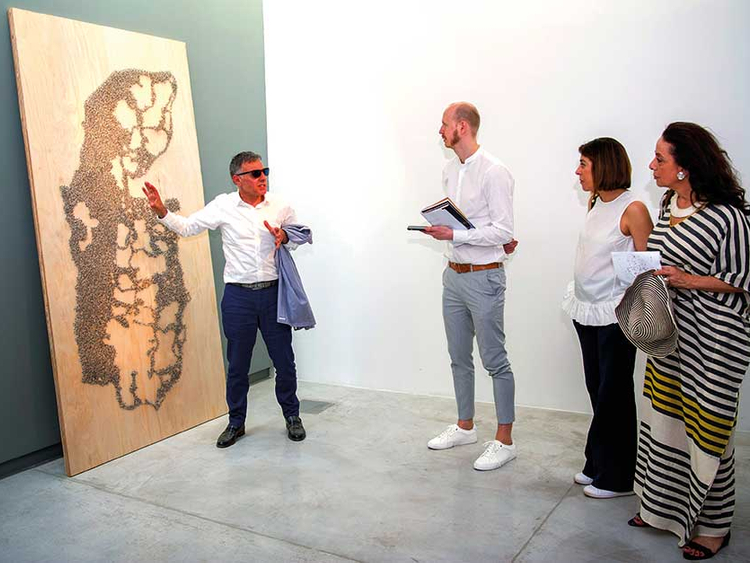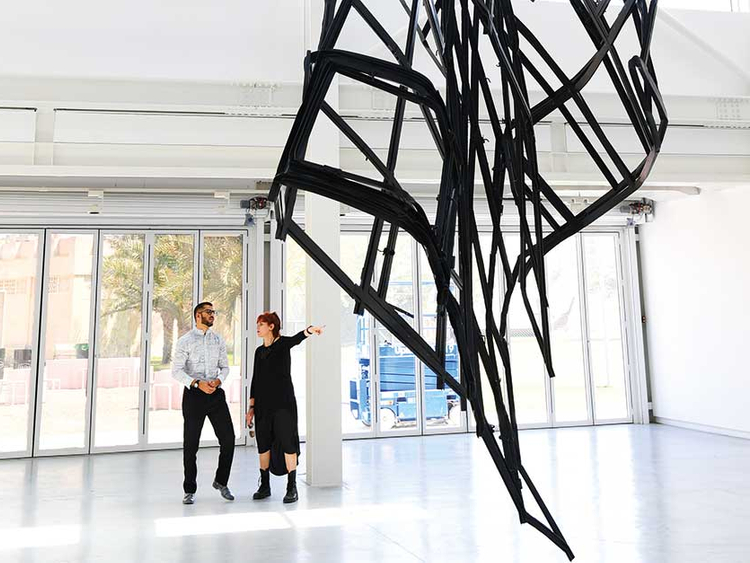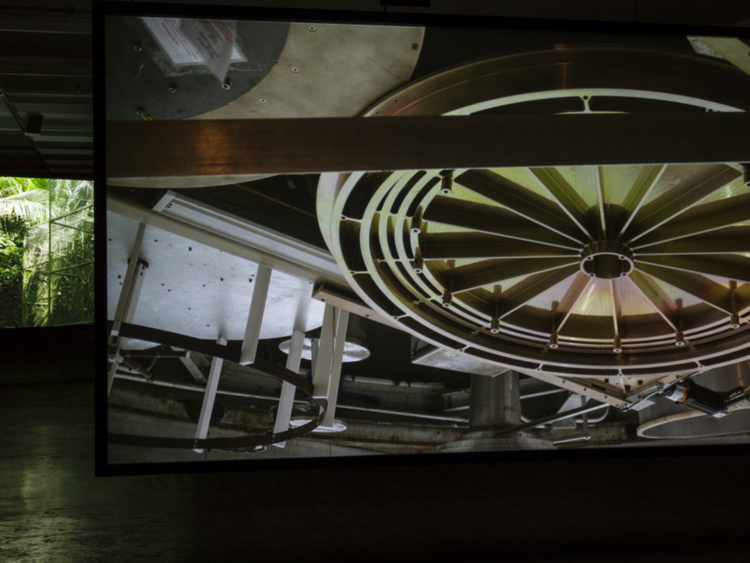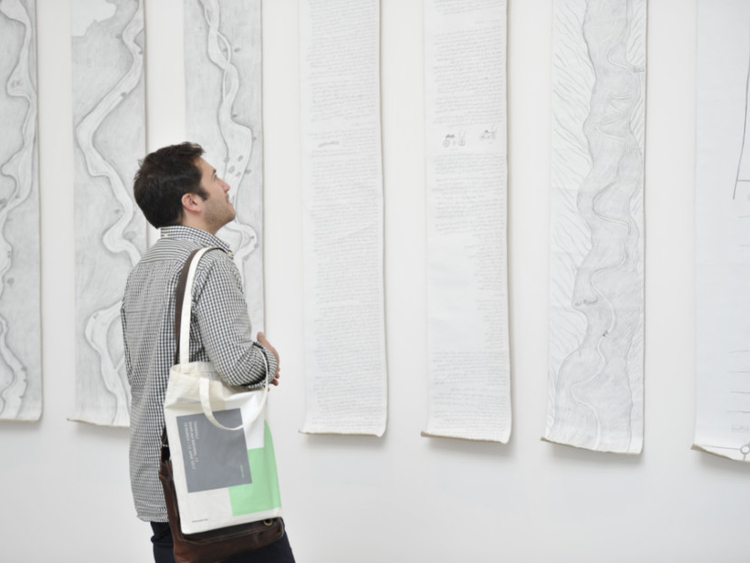
To keep pace with the 13th edition of the Sharjah Biennale (SB13) organised by the Sharjah Art Foundation (SAF), which opened on March 10, you need energy, besides of course, unbounded enthusiasm for art and ideas.
The Sharjah Biennale has been in operation for 26 years continuing “to support artists and nurture the artistic and cultural landscape of the region,” as Hoor Al Qasimi, Director and President, SAF, points out.
It was in 2003 that Al Qasimi was appointed curator of SB6 and has since been at the helm as the Biennial Director.
Al Qasimi’s choice of curator this time, Christine Tohme, is no stranger to Sharjah. As the Director of Beirut-based Ashkal Alwan, Tohme “has helped develop the cultural landscape in which we work,” says Al Qasimi.
The creative partnership between Al Qasimi and Tohme has resulted in redefining the concept of the Biennial itself as is evident during the first few days of the opening of SB13 itself. “I approached this edition as a loosely synchronous metabolism, proposing a series of maintenance processes and formulae for what a biennale is and what it could be,” says Tohme.
For SB13, Tohme has conceived Tamawuj as the theme — a noun in Arabic meaning rising and falling waves; a flowing, swelling, surging, or fluctuation; or a wavy, undulating appearance, outline, or form.
“A wave is a variation in shape that, in itself, is neither progressive nor regressive. A wave carries energy, nutrients and inspiration, at the same time, it is a vehicle for process of erosion, flooding and chemical weathering. It’s an exercise in heterogeneity, a cyclical tracing and re-tracing of form, energy and matter,” says her curatorial statement.
The conceptual framework to Tamawuj is grounded in four key words — Water, Crops, Earth and Culinary — which together form the foundations of social interaction and exchange.
“Tamawuj proposes a structure of care and cultivation and, as well as proposes a mode of working by processes of contamination, where spillage and the introduction of new elements to each other result in the formation of compounds, alter the original balance into a series of interventions,” notes Tohme.
The public programme is in two parts: Act I, the biennial exhibition and related events in Sharjah from March to June 2017, and Act II, the culmination of SB13 taking place in Beirut in October 2017.
There are other facets to the Biennial this year: an online data-rich depository of research material — ‘chip-ship’; four projects curated by four ‘Interlocutors’ outside of the UAE in the cities of Dakar, Istanbul, Ramallah and Beirut; a year-long education programme for residents of all abilities and ages in Sharjah; and a year-long online publishing platform — tamawuj.org
Off-site projects have been conceived by four interlocutors, each engaging with one keyword of SB13. Kader Attia investigated water in Dakar (January 8-9, 2017), Zeynep Oz will consider crops in Istanbul (opening May 13, 2017), Lara Khaldi will study earth in Ramallah (opening August 10, 2017) and Ashkal Alwan will reflect on the culinary in Beirut (opening October 15, 2017).
March Meeting 2017
During the opening week in Sharjah, the 10th annual March Meeting of SAF also took place from March 10-14, posing questions around, and proposing answers to, the conditions for the possibility of an art world.
The March Meeting 2017 crossed from the ideal to the material with panel discussions, talks, film screenings and various types of performances pertaining to SB13’s conceptual framework. Artists were joined by a number of curators, scholars and researchers, who formally and performatively discussed the networks and the institutional infrastructures highlighted in SB13.
One view at the seven venues in Sharjah are the works by over 70 participating artists, including more than 30 new commissions across six SAF venues — Al Mureijah Square, Calligraphy Square, Arts Square, the newly opened Al Hamriyah Studios, The Flying Saucer and Old Sharjah Planetarium.
The works displayed at SB13, as Al Qasimi says, “offer new possibilities for understanding our role within the context of great uncertainty in the world today.”
In the courtyard in front of Arts Square is the Taiwanese duo Rain Wu and Eric Chen’s impressive installation ‘Collectivism’ comprising 640 police shields enclosing a small garden and featuring a wooden platform, enabling and inviting the public to walk through the structure despite the formidable outer core.
The work, according to the artists, is inspired by the confrontation between students and police in Taiwan. First displayed at Taipei Biennial, the work examines what it is to have a mass as well as ordered resistance.
Beirut-based Joe Namy addresses the influence of opera on music in the Arab world. His installation ‘Libretto-o-o: A Curtain Design in the Bright Sunshine Heavy with Love’ resonates with the surroundings and is draped against part of Sharjah Art Museum’s façade, inviting considerable public scrutiny. The cleverly conceived play of colour and pattern is paired with an audio track located in Bait Al Serkal across the Museum, comprising short stories, poems and essays on the subject of opera.
Palestinian architect Khalil Rabah explores the relationship between art and institutions in ‘Palestine after Palestine: New Sites for the Palestinian Museum of Natural History and Humankind Departments’. Rabah draws attention to the occupation of his homeland and to the resilience of sites and symbols that exist in spite of their contested states of being.
The two Emirati artists represented at SB13 are Abdullah Al Saadi and Hind Mezaina.
In ‘The Purl and Silk Journey’, Khor Fakkan-based Al Saadi takes forward his theme of nature and travel in the form of an array of scrolls and drawings depicting the two trips he undertook. Elements of sustenance and the transformation of familiar landscapes are elegantly explored.
Mezaina’s ‘Dubai Gardens’ features a series of Cyanotype prints – a mid-19th century process of camera-less photography – a meditative interaction with the city. The textual work by Todd Reisz, and architect and writer, acts as a critical counterpoint.
Lawrence Abu Hamdan’s ‘Saydnaya (the missing 19db)’, a sound installation is a powerful exposition and part of a larger acoustic probe in to the notorious Syrian prison, 25 km north of Damascus. This investigation is a testament to the disappearance of voices and the transformation of the prison to a death camp.
Abu Hamdan’s ‘Bird Watching’, an acoustic investigation into the prison of Saydnaya prison examining the contemporary politics of listening and the importance of the earwitness, was also staged during the opening week at SB13.
Abbas Akhavan presents three interrelated works at SB13 that explore gestures of aerial projection and perspective. ‘Envelope’ is a decommissioned hot air balloon that is occasionally inflated. The balloon is a symbol of the recurring process of rise and fall — a view of civilisation as well as the cycle of breath.
Akhavan’s other work ‘Kids, Cats and 1 Dog’ is a text work installed on the Gallery 1 rooftop, calling attention to the Earth through its aerial vantage point and emphasises the destructive conceptions of development that threaten our habitation on Earth.
Akhavan’s ‘Variations on a Garden’ reflects the human desire to extend its capacity to know and to be known by those who exist beyond our immediate surroundings. The large photograph references the gold-anodised aluminium plaques bolted to the frames of Nasa’s Pioneer 10 and 11 spacecraft launched in 1972 and 1973 respectively.
Allora and Calzadilla’s ‘The Great Silence’, a 3-channel HD video examines the relationships between the living and non-living, human and animal and terrestrial and cosmic. The location is the Arecibo Observatory in Esperanza, Peurto Rico, which is surrounded by the Riyo Abajo forest, home to the last wild population of endangered Amazona vittata parrots. The script is written from the parrots’ perspective, chronicling humankind’s quest to find intelligent life.
Kader Attia’s ‘Mimesis as Resistance’, Jonathas De Andrade’s ‘O Peixie’ [The Fish], Ursula Biemannn and Paulo Tavares’ ‘Forest Law’ highlight the environment and its physical, legal and cosmological entity.
Sarnath Banerjee’s ‘All Quiet in Vikaspuri’ depicts an urban dystopia in a series of a 4-sized drawings on the fictitious water wars in Delhi. In his work, Banerjee explores greed, short-termism and the politics of thuggery.
Tonico Lemos Auad’s ‘A Moment of the Sky/Four Humours’ is a site specific installation which brings to the fore the research into medicinal plants and herbs in a garden focusing on species found in the desert. The project also features a small library, where the public can access a wide range of books on related subjects, and a programme of talks on the contemporary role and uses of medicinal plants and herbs.
Futurefarmers, a collective of artists, activists, farmers and architects, reconfigure and circumvent the prevailing logic of food policy, public transportation and rural farming networks. At SB13, Futurefarmers,’ works, ‘Seed Mast’ and Are You Receiving Me’ are linked to a seafaring project undertaken by the group.
Mario García Torres’s installation and DJ lecture ‘Five Feet High and Rising’ narrates an esoteric cultural history of rivers, charting and merging different stories of movement, migration and fragmentation.
The 13th edition of the Sharjah Biennale will close on June 12. For more information, please visit www.sharjahart.org

















